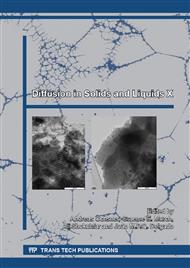p.17
p.24
p.30
p.36
p.42
p.49
p.55
p.63
p.71
Influence of Natural Ageing on Precipitation Processes during Isochronal Annealing in MgGd Alloys
Abstract:
The Mg-10 wt. % Gd and Mg-15 wt. % Gd alloys produced by squeeze casting were solution treated at 500 °C for 8 hours and subsequently naturally aged for more than 2 months. Electrical resistivity of both materials measured at 77 K decreases, if the alloys are kept at room temperature after quenching from the solution temperature. This change accompanied by a microhardness increase almost saturates after 2 months and is caused most probably by solute atoms clustering. Phase transformations and microhardness changes were investigated during isochronal annealing in both naturally aged alloys in comparison to just solution treated ones. Electrical resistivity changes measured at 77 K were used to characterize microstructure development. Transmission electron microscopy was performed at selected states heat treated in the identical way. The Mg15Gd supersaturated solid solution isochronally annealed up to 500 °C immediately after the solution treatment decomposes into following successive phases: β ́ ́ (D019) metastable → β ́ (cbco) metastable → β (Mg5Gd) stable. All three possible orientation relationship modes of the metastable β ́ (cbco) phase existed at lower temperatures (up to 280 °C) but only one mode persists up to 330 °C. Precipitation of the β ́ (cbco) phase has not been observed in the Mg10Gd alloy annealed isochronally immediately after the solution treatment. The natural ageing does not change the precipitation sequence but concentration of Gd atoms involved in individual precipitation processes is influenced in both alloys. Peak hardening increases after natural ageing in the Mg15Gd alloy, shifts to higher temperatures and the temperature region of peak hardening extends.
Info:
Periodical:
Pages:
42-48
Citation:
Online since:
July 2015
Price:
Сopyright:
© 2015 Trans Tech Publications Ltd. All Rights Reserved
Share:
Citation:


